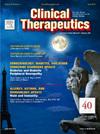Comparative Analysis of Adverse Events Linked to PEG-rhG-CSF and rhG-CSF in Real-World Settings: Disproportionate Examination of the US Food and Drug Administration (FDA) Adverse Event Reporting System (FAERS) Database
IF 3.6
4区 医学
Q2 PHARMACOLOGY & PHARMACY
引用次数: 0
Abstract
Purpose
Granulocyte-colony stimulating factor (G-CSF) is widely acknowledged for its efficacy in managing chemotherapy-induced neutropenia (CIN) and febrile neutropenia (FN), albeit accompanied by a spectrum of potential adverse effects. This study conducted a comprehensive analysis utilizing real-world data sourced from the U.S. Food and Drug Administration (FDA) Adverse Event Reporting System (FAERS) database, spanning the years 2004 to 2023, to assess and compare adverse events (AEs) associated with recombinant human G-CSF (rhG-CSF) and its polyethylene glycol-modified form (PEG-rhG-CSF).
Methods
A comprehensive analysis was conducted using FAERS data to evaluate the reporting proportion of AEs, gender-based disparities, and specific AEs such as bone pain. Statistical analyses included Reporting Odds Ratio (ROR) calculations and comparisons of median time to AE onset between PEG-rhG-CSF and rhG-CSF.
Findings
The study revealed that PEG-rhG-CSF was associated with a significantly higher number of adverse events (AEs) compared to rhG-CSF (76,155 vs. 10,953 cases). Female patients experienced a higher reporting proportion of AEs than males for both treatments, with PEG-rhG-CSF showing 54.2% of cases in females and rhG-CSF showing 46.1%, compared to 27.1% and 34.7% in males, respectively. Bone pain emerged as the most common AE, with PEG-rhG-CSF linked to 2,473 cases and rhG-CSF to 581 cases, and a higher reporting odds ratio (ROR = 1.17, 95% CI: 1.07–1.29) for PEG-rhG-CSF. Additionally, the median time to onset of AEs was shorter for PEG-rhG-CSF (3 days, IQR: 1–9) than for rhG-CSF (9 days, IQR: 2–42). Delayed AEs, such as splenomegaly, capillary leak syndrome, interstitial lung disease, and lung infiltration, were also identified, emphasizing the importance of close patient follow-up.
Implications
The study highlights significant differences in AE reporting proportion, gender disparities, and onset timing between PEG-rhG-CSF and rhG-CSF. These findings emphasize the need for close patient monitoring, especially for delayed AEs that may manifest after discharge. Further assessment of real-world data is warranted.
现实环境中与PEG-rhG-CSF和rhG-CSF相关的不良事件的比较分析:对美国食品和药物管理局(FDA)不良事件报告系统(FAERS)数据库的不相称检查。
目的:粒细胞集落刺激因子(G-CSF)在治疗化疗引起的中性粒细胞减少症(CIN)和发热性中性粒细胞减少症(FN)方面的疗效被广泛认可,尽管伴随着一系列潜在的不良反应。本研究利用来自美国食品和药物管理局(FDA)不良事件报告系统(FAERS)数据库的真实数据进行了全面分析,涵盖2004年至2023年,以评估和比较重组人G-CSF (rhG-CSF)及其聚乙二醇修饰形式(PEG-rhG-CSF)相关的不良事件(ae)。方法:采用FAERS数据进行综合分析,评估不良事件报告比例、性别差异和特异性不良事件(如骨痛)。统计分析包括报告优势比(ROR)计算和PEG-rhG-CSF和rhG-CSF的中位AE发病时间的比较。研究发现:与rhG-CSF相比,PEG-rhG-CSF的不良事件(ae)数量显著增加(76,155例对10,953例)。在两种治疗中,女性患者的ae报告比例均高于男性,PEG-rhG-CSF显示女性为54.2%,rhG-CSF为46.1%,而男性分别为27.1%和34.7%。骨痛是最常见的AE, PEG-rhG-CSF涉及2473例,rhG-CSF涉及581例,PEG-rhG-CSF报告的优势比(ROR = 1.17, 95% CI: 1.07-1.29)更高。此外,PEG-rhG-CSF组发生ae的中位时间(3天,IQR: 1-9)短于rhG-CSF组(9天,IQR: 2-42)。延迟性不良事件,如脾肿大、毛细血管渗漏综合征、间质性肺疾病和肺浸润,也被确定,强调密切患者随访的重要性。意义:该研究强调了PEG-rhG-CSF和rhG-CSF在AE报告比例、性别差异和发病时间上的显著差异。这些发现强调了密切监测患者的必要性,特别是对于可能在出院后出现的延迟性不良事件。对实际数据的进一步评估是有必要的。
本文章由计算机程序翻译,如有差异,请以英文原文为准。
求助全文
约1分钟内获得全文
求助全文
来源期刊

Clinical therapeutics
医学-药学
CiteScore
6.00
自引率
3.10%
发文量
154
审稿时长
9 weeks
期刊介绍:
Clinical Therapeutics provides peer-reviewed, rapid publication of recent developments in drug and other therapies as well as in diagnostics, pharmacoeconomics, health policy, treatment outcomes, and innovations in drug and biologics research. In addition Clinical Therapeutics features updates on specific topics collated by expert Topic Editors. Clinical Therapeutics is read by a large international audience of scientists and clinicians in a variety of research, academic, and clinical practice settings. Articles are indexed by all major biomedical abstracting databases.
 求助内容:
求助内容: 应助结果提醒方式:
应助结果提醒方式:


